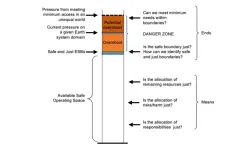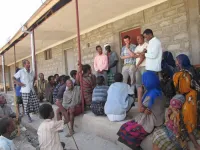(Press-News.org) Research Highlights:
A study of people ages 70 and older found walking an additional 500 steps per day, or an additional quarter mile of walking, was associated with a 14% lower risk of heart disease, stroke or heart failure.
Compared to adults who took less than 2,000 steps per day, adults who took about 4,500 steps per day had a 77% lower observed risk of experiencing a cardiovascular event.
Only about 3.5% of participants who took around 4,500 steps per day had a cardiovascular event, compared to 11.5% of those who took less than 2,000 steps per day, over the 3.5-year follow-up period.
Embargoed until 10:45 a.m. CT/11:45 a.m. ET, Thursday, March 2, 2023
DALLAS, March 2, 2023 — A new study found that walking an additional 500 steps, or about one-quarter of a mile, per day was associated with a 14% lower risk of heart disease, stroke or heart failure, according to preliminary research to be presented at the American Heart Association’s Epidemiology, Prevention, Lifestyle & Cardiometabolic Health Scientific Sessions 2023. The meeting will be held in Boston, February 28-March 3, 2023, and offers the latest science on population-based health and wellness and implications for lifestyle and cardiometabolic health.
“Steps are an easy way to measure physical activity, and more daily steps were associated with a lower risk of having a cardiovascular disease-related event in older adults,” said Erin E. Dooley, Ph.D., an assistant professor of epidemiology at the University of Alabama at Birmingham School of Public Health and lead researcher of the study. “However, most studies have focused on early-to-midlife adults with daily goals of 10,000 or more steps, which may not be attainable for older individuals.”
Participants in the current analysis were part of a larger study group of 15,792 adults originally recruited for the ongoing Atherosclerosis Risk in Communities (ARIC) study. The present study evaluated health data collected from ARIC study visit 6 (2016-17) to evaluate the potential association between daily step counts and cardiovascular disease.
Researchers analyzed health data for 452 participants who used an accelerometer device similar to a pedometer, worn at the hip, that measured their daily steps. Participants were an average age of 78 years old; 59% were women; and 20% of participants self-identified as Black adults (70% of whom were women, and 30% of whom were men).
The devices were worn for three or more days, for ten or more hours, and the average step count was about 3,500 steps per day. Over the 3.5-year follow-up period, 7.5% of the participants experienced a cardiovascular disease event, such as coronary heart disease, stroke or heart failure.
The analysis found:
Compared to adults who took less than 2,000 steps per day, adults who took approximately 4,500 steps per day had a 77% lower observed risk of experiencing a cardiovascular event.
Nearly 12% of older adults with less than 2,000 steps per day had a cardiovascular event, compared to 3.5% of the participants who walked about 4,500 steps per day.
Every additional 500 steps taken per day was incrementally associated with a 14% lower risk of cardiovascular disease.
“It’s important to maintain physical activity as we age, however, daily step goals should also be attainable. We were surprised to find that every additional quarter of a mile, or 500 steps, of walking had such a strong benefit to heart health,” Dooley said. “While we do not want to diminish the importance of higher intensity physical activity, encouraging small increases in the number of daily steps also has significant cardiovascular benefits. If you are an older adult over the age of 70, start with trying to get 500 more steps per day.”
Additional research is needed to determine if meeting a higher daily count of steps prevents or delays cardiovascular disease, or if lower step counts may be an indicator of underlying disease.
Everyone can improve their cardiovascular health by following the American Heart Association’s Life’s Essential 8: eating healthy food, being physically active, not smoking, getting enough sleep, maintaining a healthy weight, and controlling cholesterol, blood sugar and blood pressure levels. Cardiovascular disease claims more lives each year in the U.S. than all forms of cancer and chronic lower respiratory disease combined, according to the American Heart Association.
The study had limitations. Participants had to enroll in the accelerometer device study, and hip-worn accelerometers are limited in capturing other activity behaviors that may also be important to heart health, such as bicycling and swimming. Study participants were more likely to have had at least some college or above education compared to the overall ARIC sample, and primarily self-identified as white and female, which may limit the study’s generalizability. Additionally, steps were only measured at one single point in time, and the researchers were unable to examine if changes in steps over time impacted CVD event risk.
Co-authors are Brady Rippon, M.S.; Pablo Martinez-Amezcua, M.D., Ph.D.; Amanda Paluch, Ph.D.; Lisa Pompeii, Ph.D.; Priya Palta, Ph.D.; and Kelley Pettee Gabriel, Ph.D. Authors’ disclosures are listed in the abstract.
The Atherosclerosis Risk in Communities study has been funded by the National Heart, Lung, and Blood Institute, a division of the National Institutes of Health; the National Institutes of Health; and the U.S. Department of Health and Human Services.
Statements and conclusions of studies that are presented at the American Heart Association’s scientific meetings are solely those of the study authors and do not necessarily reflect the Association’s policy or position. The Association makes no representation or guarantee as to their accuracy or reliability. Abstracts presented at the Association’s scientific meetings are not peer-reviewed, rather, they are curated by independent review panels and are considered based on the potential to add to the diversity of scientific issues and views discussed at the meeting. The findings are considered preliminary until published as a full manuscript in a peer-reviewed scientific journal.
The Association receives funding primarily from individuals; foundations and corporations (including pharmaceutical, device manufacturers and other companies) also make donations and fund specific Association programs and events. The Association has strict policies to prevent these relationships from influencing the science content. Revenues from pharmaceutical and biotech companies, device manufacturers and health insurance providers and the Association’s overall financial information are available here.
Additional Resources:
Multimedia is available on the right column of release link https://newsroom.heart.org/news/for-older-adults-every-500-additional-steps-taken-daily-associated-with-lower-heart-risk?preview=8637142a895b201b4fd6026a60e6d99e
Spanish news release
Traditional Chinese news release (doc)
Video interview: American Heart Association volunteer expert, Monica C. Serra, Ph.D., associate professor and research investigator in the Department of Medicine, Division of Geriatrics, Gerontology & Palliative Medicine and the Sam and Ann Barshop Institute for Longevity and Aging Studies at UT Health San Antonio and vice-chair of the program committee for the Association’s Epidemiology, Prevention, Lifestyle & Cardiometabolic Health Scientific Sessions 2023.
AHA news release: Boosting duration, intensity & frequency of physical activity may lower heart failure risk (August 2022)
AHA news release: New study finds lowest risk of death was among adults who exercised 150-600 minutes/week (July 2022)
AHA news release: Walk this way – or any way – to better health | American Heart Association (April 2022)
AHA Guideline: 2019 Guideline on the Primary Prevention of Cardiovascular Disease
For more news from AHA EPI Lifestyle Conference 2023, follow us on Twitter @HeartNews #EPILifestyle23.
The American Heart Association’s EPI/LIFESTYLE 2023 Scientific Sessions is the world’s premier meeting dedicated to the latest advances in population-based science. The meeting will be held Tuesday-Friday, February 28–March 3, 2023, at the Omni Boston Seaport in Boston, Massachusetts. The primary goal of the meeting is to promote the development and application of translational and population science to prevent heart disease and stroke and foster cardiovascular health. The sessions focus on risk factors, obesity, nutrition, physical activity, genetics, metabolism, biomarkers, subclinical disease, clinical disease, healthy populations, global health and prevention-oriented clinical trials. The Councils on Epidemiology and Prevention and Lifestyle and Cardiometabolic Health (Lifestyle) jointly planned the EPI/Lifestyle 2023 Scientific Sessions. Follow the conference on Twitter at #EPILifestyle23.
About the American Heart Association
The American Heart Association is a relentless force for a world of longer, healthier lives. We are dedicated to ensuring equitable health in all communities. Through collaboration with numerous organizations, and powered by millions of volunteers, we fund innovative research, advocate for the public’s health and share lifesaving resources. The Dallas-based organization has been a leading source of health information for nearly a century. Connect with us on heart.org, Facebook, Twitter or by calling 1-800-AHA-USA1.
###
END
For older adults, every 500 additional steps taken daily associated with lower heart risk
American Heart Association Epidemiology, Prevention, Lifestyle & Cardiometabolic Health Scientific Sessions 2023, Presentation 360
2023-03-02
ELSE PRESS RELEASES FROM THIS DATE:
American Society for Metabolic and Bariatric Surgery supports new clinical guidance on treatment of obesity in children and teens
2023-03-02
The American Society for Metabolic and Bariatric Surgery (ASMBS) fully supports the new “Clinical Practice Guideline for the Evaluation and Treatment of Children and Adolescents With Obesity” issued from the American Academy of Pediatrics (AAP) calling for earlier and more intensive treatment of obesity in children and teens. Published in the journal Pediatrics in February, this is the first comprehensive guideline on obesity in 15 years from the AAP, the largest professional association of pediatricians in the U.S.
According to AAP, more evidence ...
Many firearm owners in the U.S. store at least one gun unlocked, fearing an emergency
2023-03-02
Most firearm owners keep at least one firearm unlocked, with some viewing gun locks as an unnecessary obstacle to quick access in an emergency, according to a Rutgers study. But when they do lock their firearms, Rutgers researchers found that firearm owners are most likely to use gun safes.
In a study published in JAMA Network Open and funded by the Defense Health Agency, researchers surveyed a national sample of 2,152 English-speaking adult firearm owners, asking them what locking devices they used and why.
Unlike previous studies, participants were presented with both words and images describing each ...
To ensure a safe and just future for people, nature and the planet, Earth System Boundaries must include justice, researchers find
2023-03-02
In a new study published in Nature Sustainability an international team of scientists from the Earth Commission, convened by Future Earth, investigates how global biophysical boundaries need to be adjusted to ensure a safe and just future for people, nature and the planet. The Earth Commission is the scientific cornerstone of the Global Commons Alliance
This new framework integrates methods to reduce harm to people, increase access to resources, address tradeoffs, and challenge powerful interests whilst addressing inequality between generations and between humans and nature ...
Genomic study of indigenous Africans paints complex picture of human origins and local adaptation
2023-03-02
Africa, where humans first evolved, today remains a place of remarkable diversity. Diving into that variation, a new analysis of 180 indigenous Africans from a dozen ethnically, culturally, geographically, and linguistically varied populations by an international scientific team offers new insights into human history and biology, and may inform precision medicine approaches of the future.
The work clarifies human migration histories, both historical and more recent, and provides genetic evidence of adaptation to local environments, ...
Energy: More than two million citizens power Europe’s renewable energy transition
2023-03-02
More than two million citizens across 30 European countries have been involved in thousands of projects and initiatives as part of efforts to transition to renewable energy, according to an analysis published in Scientific Reports. With investments ranging between 6.2 and 11.3 billion Euros, these findings highlight the important role of collective action in the decarbonisation of Europe.
The energy system in Europe is undergoing a significant transition towards renewables and decarbonisation. However, the contribution ...
Performance of outpatient surgical procedures before, after onset of pandemic
2023-03-02
About The Study: The findings of this study suggest that despite calls for the expansion of outpatient surgery to mitigate the growing backlog of surgical cases in the wake of the COVID-19 pandemic, uptake of this practice occurred in only a small subset of operations. Further studies should explore potential barriers to the uptake of this approach, particularly for procedures that have been shown to be safe when performed in an outpatient setting.
Authors: Cornelius A. Thiels, D.O., M.B.A., of the Mayo Clinic in Rochester, Minnesota, is the corresponding author
To access the embargoed study: Visit our For The Media website at this link https://media.jamanetwork.com/
(doi:10.1001/jamanetworkopen.2023.1198)
Editor’s ...
Trends, variation in the use of active surveillance for management of low-risk prostate cancer
2023-03-02
About The Study: The results of this study of more than 20,000 men with low-risk prostate cancer suggest that active surveillance rates are rising nationally but are still suboptimal, and wide variation persists across practices and practitioners. Continued progress on this critical quality indicator is essential to minimize overtreatment of low-risk prostate cancer and by extension to improve the benefit-to-harm ratio of national prostate cancer early detection efforts.
Authors: Matthew R. Cooperberg, M.D., M.P.H., of the UCSF Helen Diller Family Comprehensive Cancer Center in San Francisco, is the corresponding ...
New mutation in the desmoplakin gene leads to ACM
2023-03-02
Researchers from the group of Eva van Rooij in collaboration with the UMC Utrecht identified a new mutation that leads to the cardiac disease arrhythmogenic cardiomyopathy (ACM). They assessed the effect of this mutation on heart muscle cells and obtained new insights into the underlying mechanism that causes the disease. The results of this study, published on March 2nd in Stem Cell Reports, could contribute to the development of new treatments for ACM.
Desmosomes
Millions of heart muscle cells contract to let the heart fulfill ...
PCORI launches pioneering initiative offering up to $50 million to boost uptake of practice-changing health research findings in real-world settings
2023-03-02
WASHINGTON, DC – The Patient-Centered Outcomes Research Institute (PCORI) today kicked off a multiyear initiative with an initial investment of $50 million to advance the uptake of practice-changing comparative clinical effectiveness research results into health care practice with the selection of 42 U.S. health systems to participate in its groundbreaking Health Systems Implementation Initiative (HSII). In addition, PCORI initiated the first in two stages of HSII funding, focusing on initial capacity-building efforts.
The array of participating health systems representing a wide range of care settings and populations will develop and implement ...
Robot provides unprecedented views below Antarctic ice shelf
2023-03-02
High in a narrow, seawater-filled crevasse in the base of Antarctica’s largest ice shelf, cameras on the remotely operated Icefin underwater vehicle relayed a sudden change in scenery.
Walls of smooth, cloudy meteoric ice suddenly turned green and rougher in texture, transitioning to salty marine ice.
Nearly 1,900 feet above, near where the surface of the Ross Ice Shelf meets Kamb Ice Stream, a U.S.-New Zealand research team recognized the shift as evidence of “ice pumping” – a process never before directly observed in an ice shelf crevasse, important to its stability.
“We were looking at ice that ...
LAST 30 PRESS RELEASES:
Tracing the quick synthesis of an industrially important catalyst
New software sheds light on cancer’s hidden genetic networks
UT Health San Antonio awarded $3 million in CPRIT grants to bolster cancer research and prevention efforts in South Texas
Third symposium spotlights global challenge of new contaminants in China’s fight against pollution
From straw to soil harmony: International team reveals how biochar supercharges carbon-smart farming
Myeloma: How AI is redrawing the map of cancer care
Manhattan E. Charurat, Ph.D., MHS invested as the Homer and Martha Gudelsky Distinguished Professor in Medicine at the University of Maryland School of Medicine
Insilico Medicine’s Pharma.AI Q4 Winter Launch Recap: Revolutionizing drug discovery with cutting-edge AI innovations, accelerating the path to pharmaceutical superintelligence
Nanoplastics have diet-dependent impacts on digestive system health
Brain neuron death occurs throughout life and increases with age, a natural human protein drug may halt neuron death in Alzheimer’s disease
SPIE and CLP announce the recipients of the 2025 Advanced Photonics Young Innovator Award
Lessons from the Caldor Fire’s Christmas Valley ‘Miracle’
Ant societies rose by trading individual protection for collective power
Research reveals how ancient viral DNA shapes early embryonic development
A molecular gatekeeper that controls protein synthesis
New ‘cloaking device’ concept to shield sensitive tech from magnetic fields
Researchers show impact of mountain building and climate change on alpine biodiversity
Study models the transition from Neanderthals to modern humans in Europe
University of Phoenix College of Doctoral Studies releases white paper on AI-driven skilling to reduce burnout and restore worker autonomy
AIs fail at the game of visual “telephone”
The levers for a sustainable food system
Potential changes in US homelessness by ending federal support for housing first programs
Vulnerability of large language models to prompt injection when providing medical advice
Researchers develop new system for high-energy-density, long-life, multi-electron transfer bromine-based flow batteries
Ending federal support for housing first programs could increase U.S. homelessness by 5% in one year, new JAMA study finds
New research uncovers molecular ‘safety switch’ shielding cancers from immune attack
Bacteria resisting viral infection can still sink carbon to ocean floor
Younger biological age may increase depression risk in older women during COVID-19
Bharat Innovates 2026 National Basecamp Showcases India’s Most Promising Deep-Tech Ventures
Here’s what determines whether your income level rises or falls
[Press-News.org] For older adults, every 500 additional steps taken daily associated with lower heart riskAmerican Heart Association Epidemiology, Prevention, Lifestyle & Cardiometabolic Health Scientific Sessions 2023, Presentation 360



